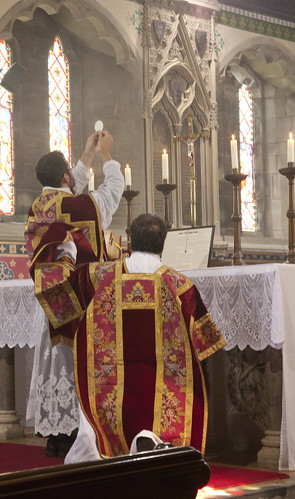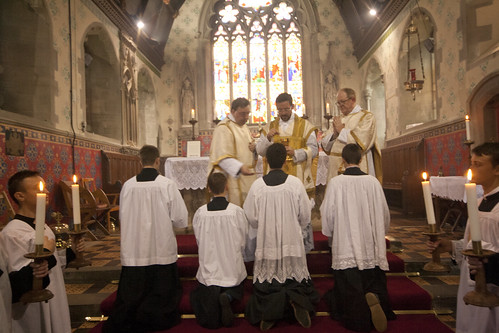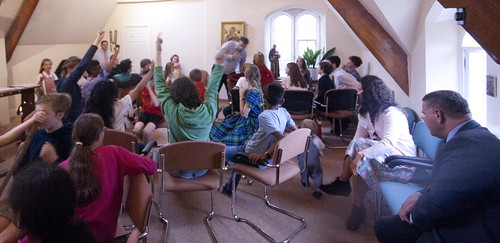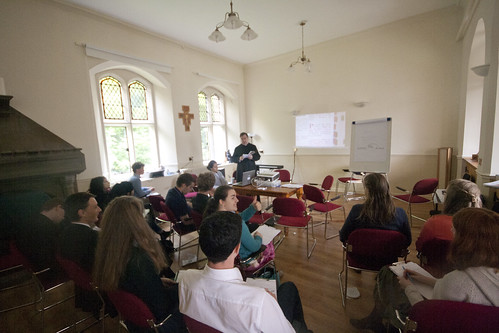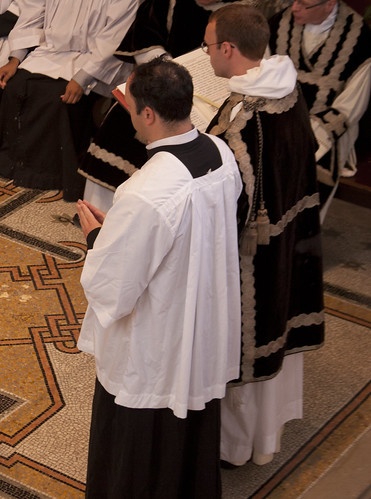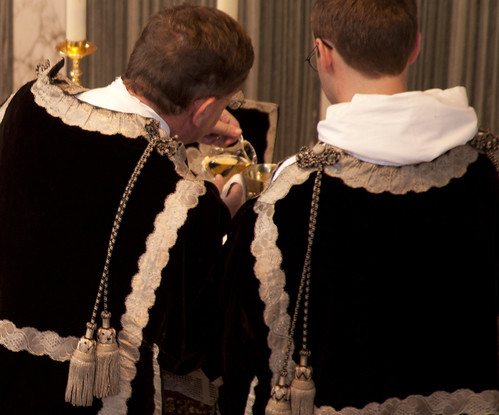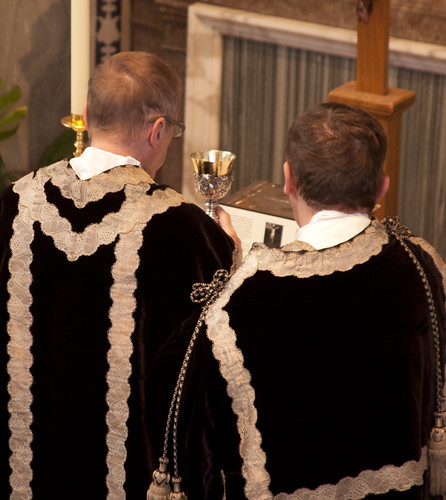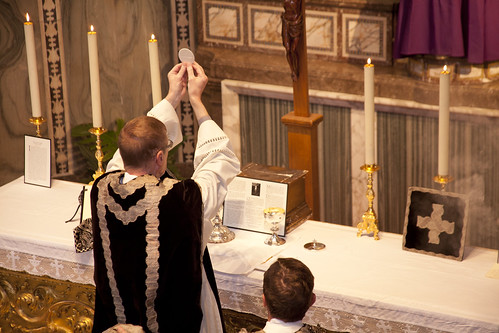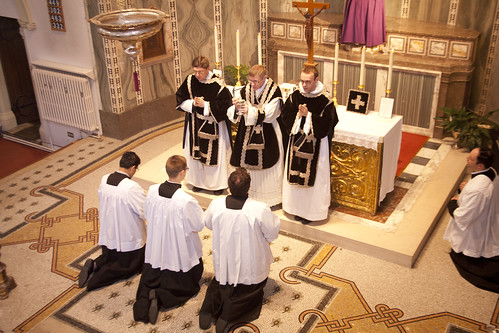Chairman's Blog
Ivereigh on converts and cradle Catholics
 |
| Our Lord surrounded by converts. |
Austen Ivereigh has done it again: driven his opponents (many of whom he helpfully names) into a defensive frenzy, one which almost seems to prove the point he is making - namely, that these individuals get worked up too easily.
I want to say something about Ivereigh's modus operandi, before saying something about the substantive issue, which is to do with the fact that Ivereigh has noted that a number of people who worry about aspects of Pope Francis' papacy are converts, not cradle Catholics.
I must be frank: I think Ivereigh is a kind of genius. Watching him debate Matthew Schmittz of First Things on Al-Jezeera is like watching a gad-fly in cambat with a sumo-wrestler. He has done the same thing in this recent post on Crux about converts. I am interested in the form as well as the content of arguments, and I recognise a master at work. How does he do it?
There is, in fact, a formula.
1. Whenever your opponent raises an objection to something you have said, don't let yourself be pinned down: just change the subject.
You have some detailed and nuanced concerns about the interpretation of Amoris laetitiae? Let's talk about converts and cradle Catholics!
This is effective in extended public debate, private conversation and televised discussion alike. Some years ago I fell into conversation with the distinguished Church historian, Prof Henry Mayr-Harting - a pretty liberal Catholic - on a crowded train from London to Oxford. He was in pugnatious mood and we argued pleasantly the whole way. But he never replied to my objections to anything he said except in such a way that I was provoked into addressing a substantially new claim that he was making. By the end of the journey I felt as if I'd spent an hour wrestling with a ghost. Since then I've seen this strategy in action from Mgr Basil Loftus as well as Austen Ivereigh.
This works by appealing, in one's defence, to principles or facts with which one's opponent strongly disagrees, and that brings us to the next part of the formula.
2. Tempt your opponent into arguing on the issues you want him to by asserting airily what you know he will disagree with.
There are issues, and sub-issues, and specific examples, about which one side of any debate looks or weaker. Why waste your time arguing over the ones where you look relatively weak, when you can force your opponent to spend all his time focused on the ones on which you look relatively strong? How can you do this? By provoking him to follow you into these sub-issues, and throwing in your favoured examples even if they are irrelevant to the matter in hand. It works best with an opponent who keeps thinking: 'I can't let that claim go unchallenged, particularly on TV! People might think I agree with it.'
Now, if you actually want to persuade your interlocutor of a specific point, you need to avoid appealing to things you know he rejects, so it might appear that this strategy is self-defeating. But that would be to assume that the purpose of debate is to persuade the opponent or anyone in the audience who was inclined to agree with him, and that would be a mistake. Rather, the final part of the formula is this:
3. Provoke outrage in your opponent by outrageous and insulting assertions.
The purpose of the debate, for people like Loftus and Ivereigh, is not to persuade, but to lessen their opponent's effectiveness. One way of doing this is by moving the debate to places where he looks less good, as noted above. Another is by inducing some degree of spluttering rage. The hoped for result is to infuriate and humiliate him, and in this way to silence him and his supporters. This works particularly well where the audience is not well-informed on the subject at issue, and best of all when the audience is a liberal or a secular one. Anyone, indeed, who is not following the argument is some detail - and Ivereigh is careful to make the path of argumentation dizzyingly serpentine by constantly changing the subject - is reduced to scoring the debate on the basis of which of the debaters is looking calm and self-satisfied and which is looking defensive and hot under the collar. The result is that Ivereigh comes out looking like the victor even if his opponent has given a series of his claims crushing ripostes. Ivereigh gives no sign of being crushed, and everyone watching is too confused to know what's going on.
In a stand-alone article or blog post the above formula is adapted: the trick here is to make so many outrageous or insulting claims that opponents start spluttering from the start, and onlookers think: here is the masterful Ivereigh, cool and collected, and there are a bunch of people shouting and getting red in the face.
I realised, in addressing the appalling weekly columns of Mgr Loftus, that it would take a small book to go into all the asinine claims of just one week's output. Admittedly, after a while you notice that he is repeating himself a good deal. But all the same, a thorough response would be a full-time job. And that's two birds with one stone, isn't it? A pile of theological nonsense purveyed to the public, and a potentially effective opponent tied up in knots looking to most people like a nit-picking member of the Spanish Inquisition.
Ivereigh is an incomparably more sophisticated media operator than Loftus, but what's is particularly striking about his latest column is how appallingly rude it is. He doesn't just casually refer to his opponents as neurotics: he goes to some lengths to suggest he is using the word in a technical, medical, sense. He is really, truly, saying that half a dozen named Catholic journalists and commentators are mentally ill, for the simple reason that they disagree with him. Outrage is absolutely appropriate, but I fancy it will get us all nowhere.
It is important to notice that if a conservative Catholic tried this schtick, it wouldn't work. One important reason is that a conservative who baited his opponents with outrageous claims and insults would not be tolerated by his fellow conservatives. (This happens from time to time.) Liberals, on the other hand, are happy to let each other get away with this sort of thing, not because they all agree with all the detailed claims - far from it - but because they are happy to see them being used in the great war against orthodoxy which they all support. Does John Allen, for example, agree with Ivereigh's absurd claim that the Pope is 'chosen by the Holy Spirit'? I doubt it. But for the duration of Pope Francis' papacy, he's happy to publish Ivereigh's liberal ultramontanist ravings because they are tactically effective. (I've written more about this here.)
I suppose it's worth stating the obvious, that the approach I've described deepens divisions and embitters opponents, and that it is contrary to charity and intellectually dishonest. But hey, all's fair in love and war, isn't it?
So, what of Ivereigh's substantive point about converts? Well, it is very simple. Converts in general view the Church in terms of theology and ideas, because they have come into the Church, usually, because of theology and ideas. Cradle Catholics can fall prey to the temptation to see their Catholic identity as a tribal thing. If the Church were somehow to change her teachings, tribal Catholics would, obviously, be less troubled than intellectual converts. There are in fact plenty of cradle Catholics who understand that the Church is not some quasi-ethnic or cultural group, or a cosy club, but actually a community defined by adhesion to the message of the Gospel and the Church's authority and sacraments. We are blessed, however, with a particularly high proportion of converts who recognise this reality without any prompting.
So, God bless you, Matthew Schmitz, Rusty Reny, Edward Pentin, Carl Orlson, John Henry Westen and Daniel Hitchens! All personally demonised by Austen Ivereigh, but gifts indeed from the Holy Spirit to the Church: the Holy Spirit which in every age refreshes the Church with converts. Heaven knows, we cradle Catholics have done little indeed to deserve your assistance.
Support the work of the LMS by becoming an 'Anniversary Supporter'.
Come to Walsingham with the Latin Mass Society!
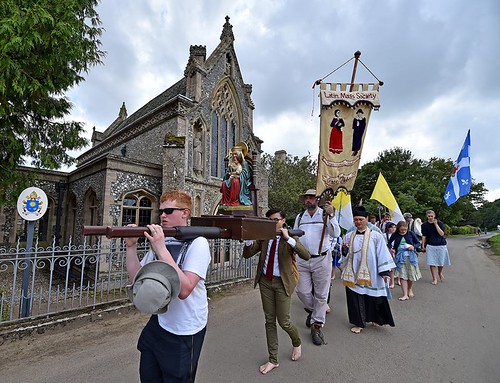 |
| LMS Pilgrims outside the Slipper Chapel at the Catholic Shrine to Our Lady of Walsingham |
Support the work of the LMS by becoming an 'Anniversary Supporter'.
Family Day with the Friars in Gosport 12 Aug
I'll be giving a talk during a Family Day organised by the Friars in St Mary's, Gosport, on Saturday 12th August.
St. Mary’s Church, 32 High Street, Gosport, Hampshire, PO12 1DFTel: 023 9258 0119(* During the talks for the Adults there will be talks and activities for the Children and an opportunity to receive the Chord of St. Philomena)9:30 am - Holy Rosary10:00 am - Solemn High Mass (in the Extraordinary Form) for the Feast of St. Clare of Assisi.12:10 pm – Opening welcome12: 15 - First Talk – ‘The Crisis of the Father’ by Dr. Joseph Shaw Chairman of the Latin Mass Society (Including a Question and Answer session).1:00 pm – 2:00pm - Lunch (please bring some food to share if you can).2:15 pm – 3:00 pm - Second Talk – ‘Fatima and Marriage’ by Fr. George Mary Roth (talk will be given in the Church).3:00 pm – Holy Rosary (in the Church).3: 30pm – 4: 00 pm – Tea Break and Social gathering.4: 00 pm – 4:45 pm – Third Talk – ‘Why we home school and how it works’(Including a Question and Answer session).4:45 pm – 5: 00 pm – Short break.5: 00 pm – 5: 45 pm – Fourth and Final Talk – ‘Presentation on Modesty for women and girls’ by Mrs. Elizabeth Dulston (Including a Question and answer session).5:45 – 6:15 pm – Further discussion and talk with our speakers.6:30 pm – Conclusion with Exposition of the Blessed Sacrament and Solemn Vespers.Please check for local parking.
Support the work of the LMS by becoming an 'Anniversary Supporter'.
A modest proposal about the public treatment of mothers
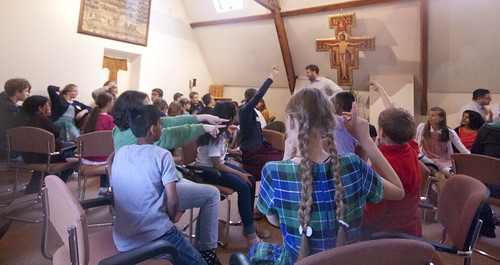 |
| Quiz at the SCT Summer School |
During a discussion of large families and (inevitably) of Natural Family Planning, on Facebook, one of my FB friends remarked:
We suffer both extremes, those who feel the need to take it upon themselves to make such invasive and snarky comments, that think NFP is there to make sure you only have a respectable number of kids, or, as I call them, NFP crusaders; and on the other hand certain trads that think all NFP is evil and even if you are dying you have to keep popping out kids (even though permission for NFP goes back to Bl. Pius IX).
I don't think this is simply a Catholic problem arising out of the debate about Catholic teaching. It is, rather, a Catholic version of a wider phenomenon. Another commentator had started off the discussion by pointing out, of parents, and particularly of mothers, with more than two children:
Everywhere they go they are mocked, scorned and insulted. They are accustomed the most unpleasant and intrusive commentary on the most intimate part of their life: being asked whether they haven't yet found out where babies come from, or why they don't get a television to assist them limit their family size, is a regular and frequent occurrence. They are attacked on public transport, in shops, in their own homes by visiting engineers and delivery men...
It reminds me of stories about young men being accosted in the street during the First World War about why they had not volunteered for the army, or presented with the white feathers of cowardice. The imperative of the war had made it everyone's business, and people made accusations first and enquiries later: the enquiries themsevles being a violation of privacy, as if people had a duty to parade their health problems. The war made possible an orgy of self-righteousness, which seems to be the most pleasurable of all the emotions.
Support the work of the LMS by becoming an 'Anniversary Supporter'.
Letter in The Tablet: Liturgical pluralism
I was pleased to see John Baldovin SJ (Towards the summit, 22nd July) distinguishing the question of the 'Reform of the Reform' of the Ordinary Form from the question of the Extraordinary Form. The conflict over the first is fought out in parishes up and down the land. By contrast, there need be no conflict between the two forms. The celebration of one need not impinge on those who attend the other, if each is given proper space.
Fr Baldovin complains, however, that it is anomolous to have two 'forms' or rites in the Latin Church. He appears to have forgotten that the Roman Rite has long embraced Dominican, Norbertine, Carthusian, and other usages, the remnants of a still greater variety from the days of the Sarum and Gallican Missals. The anomoly, surely, is in the post-conciliar liturgical homogenisation, which flies in the face of the Council's instructions: Sacrosanctum Concilium 37 rejected 'rigid uniformity' (cf. Unitatis redintegratio 17).
What puzzles me most however is Fr Baldovin's quest for ulterior motives in those attracted to the ancient Mass, such as a stronger Catholic identity, or a rejection of the Council. He himself writes that it can be 'wonderful, a thing of beauty', 'a kind of reverent transcendence that is often lacking' in the OF. Isn't this explanation enough? And should we not be encouraging the celebration of such a liturgy?
Yours faithfully,
Joseph Shaw, Chairman, The Latin Mass Society
Support the work of the LMS by becoming an 'Anniversary Supporter'.
St Catherine's Trust Summer School: some photos
 |
| The end of school quiz. |
The St Catherine's Trust Summer School took place last week: it runs from Sunday to Sunday. Numbers have gone up every year for several years, and we welcomed 39 children this year. There was a full minibus load from London, and nine travelled by train from Scotland.
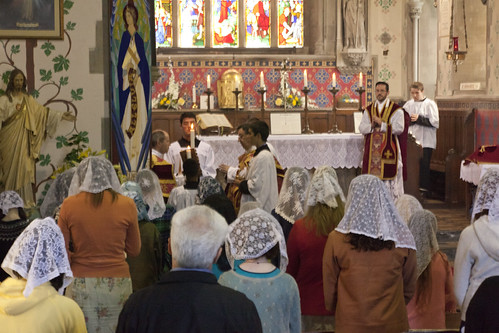 |
| High Mass, with Fr Richard Bailey celebrating and Fr Aidan Keiran as subdeacon: these priests were involved with the Latin Course which runs alongside the Summer School. |
The Summer School exposes children to a week of traditional liturgy, which they would only otherwise experience by visiting a monastery. We have sung - usually High - Mass every day, sung Compline each evening, Benediction twice in the week; each day begins with the Rosary. We always have Stations of the Cross on Friday.
We have a couple of visiting speakers: this year is was Canon Scott Tanner ICKSP from New Brighton, and Fr Mark Higgins from Ramsgate. They gave us Benediction after their talks.
There are, of course, lessons. This isn't a Summer Camp: we do have games and activities and outings, but a lot of the week is spend in classrooms, divided up into three groups. Our Chaplain, Fr Andrew Southwell, teaches Catechism every day; we also have drama, history, philosophy, history of art and whatever the teachers feel inspired to talk about. Naturally, we also give an introduction to Latin, and even Greek, and teach Gregorian Chant. This year we had a couple of polyphonic motets at the final Mass which were prepared during the week.
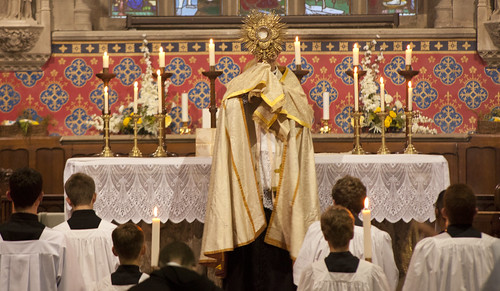 |
| Canon Scott Tanner ICKSP gives Benediction |
The venue is the attractive Franciscan friary and retreat centre of Pantasaph, which includes the Pugin church of St David's, in the lovely Welsh countryside. It is a short distance from the Catholic shrine of St Winefride's Well at Holywell.
 |
| Compline |
This year we visited St Mary's, Warrington, which now belongs to the Fraternity of St Peter and celebrated Mass there; and we visited Chester, the site of two early Christian martyrdoms, and one of England's most picturesque cities.
The first of our Summer Schools took place in 2005, and we have the same core team. We have been in three different venues, but we've been at Pantasaph for a few years now and I hope we'll remain there. It has been interesting to see whole families of siblings pass through the school, to watch them grow up. It has been a privilege to teach them.
They keep coming back, so clearly we're doing something right! It is all made possible by the sponsorthship of the Latin Mass Society, and others: a big thank you to all our supporters, including the very generous parents. This support makes it possible for us not to charge a fee: a core principle of the school.
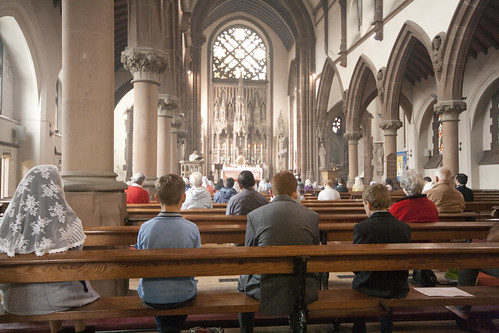 |
| St Mary's Warrington |
Support the work of the LMS by becoming an 'Anniversary Supporter'.
Clifford Longley on what Latin expresses
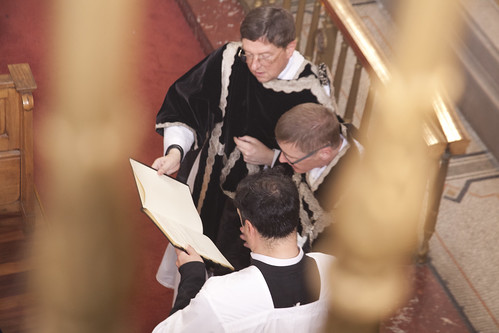 |
| Prayers for the Absolution at the Catafalque at a Requiem Mass: Fr Mark Elliot Smith (centre) at Our Lady of the Assumption, Warwick Street. |
Clifford Longley is not a man I expect to agree with: still less his column in The Tablet, which I've criticised here and here. Last weekend, however, he said something, in his own way, which I have been saying a lot recently, particularly in the talk I gave at the Roman Forum in the Gardone Riviera.
This is an extract. Subscribers can read it all here.
He starts by noting that people who attend the Mass in English do not, actually, understand it: 'They get the essentials, but it’s a fair bet a lot of important stuff goes right over their heads – as it does over mine.' He continues:
The obvious reason for changing the language in the liturgy to that normally spoken by the congregation was to help them understand it. Latin was seen as a barrier. But the use of Latin also conveyed something else – that what the liturgy was dealing with were sacred mysteries, with hints of hidden meanings that could never be fully expressed or explained and did not belong in the ordinary day-to-day world of everyday speech.
For instance, take the phrase from the Gloria – Qui sedes ad dexteram Patris, which is translated into English as “Seated at the right hand of the Father”. That is a solid mental image, stripped of poetry and mystery. Translating it into English rips away the veil that the Latin supplied. That veil served a purpose. It said: “Here is something out of reach, something more than poetic analogy, that should not be exposed to the merciless light of rational analysis.” The Gloria is a love poem, not a seating plan.
Yet rational analysis and the use of literal imagery are precisely what the use of English invites. It certainly does not make the mystery easier to understand. Whatever Qui sedes ad dexteram Patris was meant to convey, the original thought sails over our heads uncomprehended, like a cricket ball beyond the outstretched hands of the fielder, while our mind wrestles with impossible questions – “How can the Son of God sit? How can God have a right hand?” – and we draw a puzzled blank expression.
The argument is made at greater length in the Position Paper on 'Latin as a Liturgical language' here.
Support the work of the LMS by becoming an 'Anniversary Supporter'.
Me interviewed by Michael Matt of The Remnant
Support the work of the LMS by becoming an 'Anniversary Supporter'.
More on 'liturgical reconciliation'
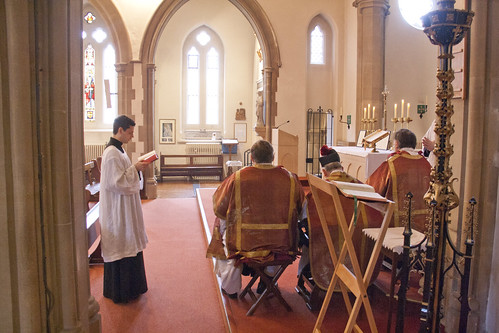 |
| The Prophecies of the Ember Saturday (of Lent, in this case). A feature of the OF lectionary which I haven't even mentioned. |
The debate about the possible development of the 1962 Missal in the direction of the Ordinary Form, raised by Cardinal Sarah, has brought to light some extra points I'd like to highlight.
Fr de Souza, whose Catholic Herald article on an interview given by Cardinal Sarah initiated the discussion, has written a follow-up piece in which he refers to my Catholic Herald blog post, a post on the New Liturgical Movement by Gregory diPippo, and one by Fr John Zuhlsdorf. It is nice to see us presenting a completely united front, which Fr de Souza notes. But he doubles down on his claim that the superiority of the Ordinary Form Lectionary is 'almost unanimous', except, it would seem, among those (like the three of us) who disagree...
It is certainly very widely said that the OF Lectionary is superior, but though I have seen this sentiment expressed countless times, I have not encountered much in the way of reasoned defence of it in light of criticisms. People think it is just obviously better because it is larger, a quite amazingly lazy argument which runs out of steam as soon as anyone points out that 'more is not necessarily better'. Very few supporters of the OF have bothered to read anything about the liturgy written by Traditionally-minded Catholics, but doubts about the new Lectionary have been around for a long time. I recall one of the first things I read on the liturgical reform, Michael Davies Pope Paul's New Mass, in which Davies suggested out that the three lections on a Sunday overloaded the 'Liturgy of the Word' in relation to the 'Liturgy of the Eucharist', and overloaded the listener who could not be expected to take in three different texts, all probably unfamiliar, some rather obscure, and one not thematically related to the other two.
Davies, who was a long-standing prep-school teacher, further pointed to the fact that if you tell children two stories in quick succession, afterwards they can usually only remember the second. That suggests, in fact, a more optimistic assessment than the facts of experience are able to confirm. Just ask the people coming out of a Novus Ordo Mass what the readings were for yourself.
This is hardly the last word on the subject; I mention Michael Davies because he was making these criticisms, which should at least be addressed, back in the 1980s. Few, I fancy, of the OF supporters who glibly say that their lectionary is 'obviously better' have caught up even with these venerable points, let alone the FIUV Position Paper on the subject, or Matthew Hazell's book comparing the two lectionaries, or any of the rest of the stuff which has come out recently.
As Gregory diPippo says:
I also cannot imagine why Fr de Souza writes that “there is wide consensus that the OF lectionary is superior,” when almost every feature of it has been argued against and contested from every point of view. The new lectionary’s creators were thoroughly convinced that they were restoring an ancient custom of the Roman Rite when they introduced the three-reading system for Sundays and solemnities; this is now known to be completely untenable.
On the more general question of co-existence, Fr de Souza appears to concede the point. Fr Z quotes a speech of Pope St John Paul II which I did not know, which is helpful here (26 October 1998) (Fr Z's emphasis):
In order to safeguard the treasure which Jesus has entrusted to her, and resolutely turned towards the future, it is the Church’s duty to reflect constantly on her link with the Tradition that comes to us from the Lord through the Apostles, as it has been built up throughout history. According to the spirit of conversion in the Apostolic Letter Tertio millennio adveniente (nn. 14, 32, 34, 50), I urge all Catholics to perform acts of unity and to renew their loyalty to the Church, so that their legitimate diversity and different sensitivities, which deserve respect, will not divide them but spur them to proclaim the Gospel together; thus, moved by the Spirit who makes all charisms work towards unity, they can all glorify the Lord, and salvation will be proclaimed to all nations.
Gregory diPippo makes the important distinction between the Temporal and Sanctoral Cycles of the two Forms. Talking about the Lectionary and Feastdays in the same breath obscures this very important distinction. Certainly, saints' days have, of course, changed over the centuries, as new ones are added and so forth.
The Temporal cycle, on the other hand, was one of the stablest parts of the Roman Rite throughout its long and varied history. There are few notable differences between the features of it attested in the oldest Roman lectionaries and sacramentaries in the seventh and eighth centuries, and that of the Missal of St Pius V; those which do exist consist almost entirely of the addition of feasts such as Corpus Christi. It hardly needs repeating that the fathers of Vatican II did not in any way ask for or envision the drastic mutilation of the Temporal perpetrated by the post-Conciliar reformers.
Fr de Souza notes another point of Fr Z's: that adherents of the Traditional Mass have been, to put it mildly, been traumatised by their experiences of recent decades, and any talk of 'reconciliation' needs to take this into account. The obvious thing, in fact, is to let some time pass without any further wrenching changes to the Old Mass: however strong the case may be for tinkering with the New Mass.
Support the work of the LMS by becoming an 'Anniversary Supporter'.
A Requiem in London: on silent and hidden liturgy
Yesterday I attended a High Mass of Requiem in London, in the lovely Church of Our Lady of the Assumption, Warwick Street. I was able to take photos from the gallery, which is enormous: not just a choir loft but a large seating area, curving round both side walls of the church so that the wings are close to the sanctuary of the church: a brilliant place from which to see what is happening.
It struck me how much of the Traditional Mass is not, in fact, intended to be seen at all. Even from this advantageous viewpoint, I only saw glipses of the priest's hand gestures (each of which has a distinct meaning), the blessing of the incense, the pouring of wine and water in the chalice, the lavabo, and so on. It was a High Mass, and in certain points the deacon and subdeacon formed a more complete screen than the servers usually would.
But of course it is the same with the texts. At High (or, indeed, Sung) Mass the Prayers of the Foot of the Altar are inaudible to the congregation, because there is singing going on. At any Mass the Offertory and Canon are silent. And there are all sorts of other texts spoken in a 'low voice': some of which are said in a low voice at the Novus Ordo too, such as the Lavabo prayer (much truncated in the Ordinary Form, but still not supposed to be heard by the Faithful).
There is still plenty to see, and to hear: the senses are certainly not starved, and indeed certain things are made very clearly and beautifully visible and audible indeed, creating a very intriguing and satisfying series of contrasts. But it remains a challenge to any conception of the liturgy which places the edification of the people in the first place. Invisble ceremonies and inaudible words are not, in the normal way of things, going to serve to instruct the people.
We have to adopt a different way of thinking about the Mass. It does instruct the Faithful, but that is not its primary goal. It is true that the carefully busy priest at the altar doing we-know-not-what is itself a lesson, but a lesson in what, exactly?
The point of these ceremonies and texts is that they are liturgically appropriate, indeed called for. They are part of a liturgy which expresses in all sorts of ways the things which we want it to express, addressed not to us, but to God. And they are part of a ritual which has an objective value and efficacy. The blessings and, above all, the consecration of the Sacred Species, is something which happens really, objectively, and it is important for us to know that it does so: it is not dependent on the Faithful's response, any more than on the priest's worthiness.
This is, or should be, particularly clear in a Mass for the Dead. The souls of the departed are not in need of edification by human means. They are in need of our prayers and of the offering of the Mass for them. And that is what, in the traditional Mass, they unequivocally receive.
This Mass was celebrated by Fr Mark Elliot Smith, Parish Priest, assisted by Fr Michael Cullinan (deacon) and Br Albert Robertson OP (subdeacon). It was ccompanied by Cantus Magnus under the direction of Matthew Schellhorn. The occasion was the year's anniversary of the burial of Anthea Craigmyle.
Support the work of the LMS by becoming an 'Anniversary Supporter'.


